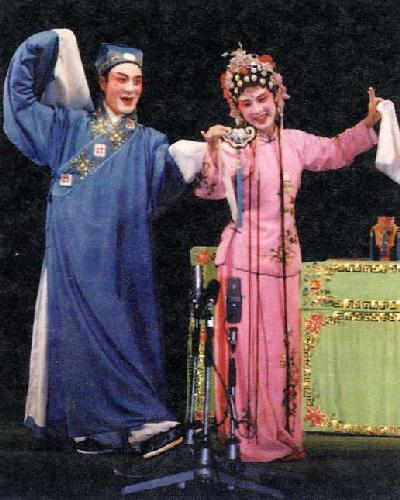During the Song Dynasty (960-1279), Wenzhou was an important trading port with a large population. Though it was not as prosperous and bustling as the cities in northern China, it enjoyed more freedom, since it was far away from the central government. When the internal and external conditions were ripe, a fully developed Chinese theater sprang to life, in the form of the Southern Drama.
 |
| A scene from "Zhu Wen and the Taping Coins" performed by the Pear Garden Opera Troupe of Fujian Province |
The Southern Drama combines singing, dancing, spoken parts of a Chinese opera, and
Kefanto perform a complete story. Due to relatively labyrinthian plots, Southern Dramas are usually feature-length. A Southern Drama may have more than 50 scenes at the longest, and as much as 20 to 30 scenes at the shortest.
The Southern Drama was also known asYongjia ZajuorYongjia Drama, as it was born in Yongjia (present-day Wenzhou). To distinguishYongjia Zajufrom theZajuof northern China, the local people named it Southern Drama. The earliest Southern Dramas includedZhao ZhennuandWang Kui. The scripts of these two dramas have been lost, but we know from other sources that they described how poor scholars abandoned their wives and married the daughters of high officials after they passed the highest imperial examination and became officials themselves.
During the 200 years from the Song to the Yuan (1271-1368) dynasties, there must have been a large number of such dramas. However, as these dramas were created and performed by ordinary people, not scholars, they were not written down; only fragments remain.
In the Southern Drama there were five stereotyped characters:Sheng(male characters),Dan(female characters),Jing(orFujing, painted face),Mo(orFumo) andChou(male clowns). TheJingandMo, which originated in the ancientCanjunandCanggu, were comedy roles, together with theChou). The five main roles --Sheng Dan, Jing, MoandChou(in the Southern Drama were inherited by later Chinese theatrical arts. The other two roles in Chinese opera areWaisheng(minor male characters) andTiedan(minor female roles). In general, a story unfolded with theShengandDancharacters at the core to carry the main plot. The subject matter of the Southern Drama was usually serious, and performances were done very earnestly. As compared with the performances of former ages, focusing on comic gestures and remarks, the Southern Drama marked great artistic progress, with impromptu comic gestures and remarks by theChou,JingandMobeing used for defusing tension.
The Southern Drama not only affirmed, but also abided by the principle of Chinese theater of exaggeration and symbolism based on illusion. A major drama required the presentation of a large number of places and long periods of time, which taxed the resources of the simple stage and the skills of the performers. When performing Southern Dramas, actors brought into full play their imaginations to display flexible and shifting time and space on the stage. For instance, inTop Scholar Zhang Xie, when Zhang Xie and other young scholars leave home for the capital to take part in the imperial examination, they need to make a long and arduous journey. This is done very simply on the stage, with the actors taking turns to sing, "We have covered oneliafter another." In a word, since the birth of drama in China, neither actors nor audiences have ever required vivid realism.
